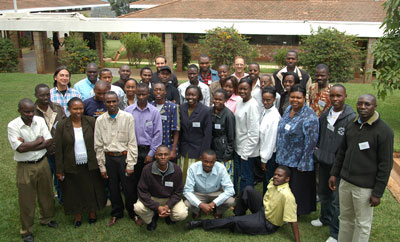Livestock are often neglected in water management policies, yet demand for livestock products is predicted to soar, placing even greater pressure on scarce water supplies. A new brief outlines strategies and opportunities to double livestock water productivity.
Water management policies tend to focus on water productivity in crop production and industrial and domestic use. Livestock are given little attention. A new brief entitled ‘Integrating livestock and water management to maximize benefits’, highlights the important contributions livestock make to livelihoods, particularly in developing countries, and the need for livestock to be fully considered in water management policies in order to maximize benefits.
Demand for livestock products are predicted to double over the next twenty years and this will place greater pressure on already scarce water supplies. Livestock contribute to the livelihoods of at least 70% of the world’s rural poor, providing many benefits including food, fuel, fertilizer and transportation. According to ILRI scientist Don Peden, ‘integrating livestock and water could bring big benefits, but it is receiving little attention in the livestock and water sectors.’
|
Livestock water productivity Livestock water productivity is the amount of water depleted or diverted to produce livestock and livestock products and services. Livestock require a great deal of water – not for drinking – but for their feed. Livestock water productivity can be increased by identifying areas where water efficiency gains can be made to free up scarce water for other uses. |
Many people in industrial countries eat more food than is necessary and healthy.
‘Health experts and environmentalists in industrial countries are calling for people to reduce their consumption of meat and dairy products. In the developing world, nutritionally deprived people could benefit from consumption of more animal products’ says Peden.
‘The challenge is to enable poor livestock keepers to get more from their animals, while using less water and reducing degradation of land and water resources.’ The convergence of high livestock densities and poverty occurs mostly in South Asia and sub-Saharan Africa. To help the greatest number of livestock-dependent rural poor, these two regions would therefore be priority regions for integrating livestock and water development.
Distribution of poor livestock keepers (no.km3)
Strategies for improving livestock water productivity
The brief outlines four strategies for improving livestock water productivity, to reduce the amount of water used in livestock production and to increase the benefits from livestock per unit of water used. The authors argue that by taking a balanced site-specific approach, that combines all four strategies, it should be possible to at least double livestock water productivity.
- Strategic sourcing of animal feeds – Reducing the amount of water depleted to produce animal feed may be one of the most effective ways to improve water productivity globally. Three basic ways of accomplishing this are (i) promoting non-grain food sources with high water productivity, (ii) use of crop residues and by-products as feed, and (iii) practices that encourage more efficient grazing.
- Enhancing animal productivity and reducing herd sizes – In much of the developing world livestock productivity is less than 50% of genetic potential. Milk production is low – often less than two litres per cow per day – as opposed to 15 litres or more. Promoting better health, genetics, nutrition and animal husbandry practices would enable livestock keepers to get more from fewer animals.
- Reducing negative environmental impacts – Loss of vegetation due to overgrazing results in increased soil erosion, downslope sedimentation and reduced water infiltration. Research indicates that low to moderate grazing pressure has little negative impact on hydrology. Managing animals in ways that reduce land and water degradation, for example, by restricting animal access to certain areas and more integrated management of grazing land will help to reduce negative environmental effects.
- Strategic provision of drinking water – The amount, quality and location of livestock drinking water can have a big impact on livestock water productivity. Water deprivation reduces feed intake and can greatly lower milk production. Providing adequate quality drinking water – strategically placed – enables animals to reach otherwise inaccessible grazing areas, keeps them from contaminating domestic water sources, and enhances production of meat and milk. Given the high value of animals, particularly to poor households, and the relatively small amount of water animals drink, strategic provision of drinking water is a good investment.
The authors argue that the livestock water productivity opportunities identified in the brief can only be realized if livestock and water are fully integrated and location-specific adjustments are made, for example, at the community level and integration of pasture management and water users associations.




.jpg)










